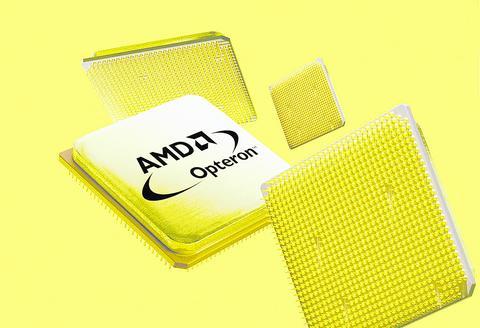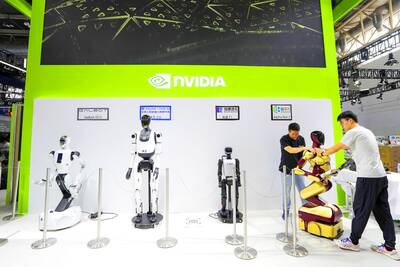Intel will face its strongest challenge in more than a decade when its archrival, Advanced Micro Devices, formally unveils the Opteron 64b microprocessor next week.
Opteron represents a determined attempt by Advanced Micro to undermine Intel's blueprint for dividing the computing universe into two separate worlds: one represented by its desktop 32b Pentium processors; the other by its pricier, corporation-oriented Itanium 64b chips. In doing so, Advanced Micro is attempting to blur the line between the two computing categories, positioning its new processor as a simpler transition for software designers and computer users from the now-standard 32b chip architecture to 64b, which shatters the limit on computing memory from 4 billion bytes to what, for all practical purposes, is an unlimited ceiling.
But Advanced Micro, which competes directly against Intel in both microprocessors and in the market for flash memory chips, which are widely used in consumer products like cellphones, faces a big challenge in its attempt to chip away at Intel's powerful status in the industry. Indeed, many industry executives see the Opteron processor and the Athlon 64 -- its companion desktop version to be released this fall -- as a make-or-break test for AMD as it tries to carve out a secure, profitable position within Intel's shadow.

PHOTO: NY TIMES
Last week, AMD, while surpassing Wall Street expectations and claiming to have gained market share against Intel, reported a US$146 million loss for the quarter on revenue of US$715 million. AMD, based in Sunnyvale, California, has reported losses in four of the past five years and badly needs for Opteron to be a hit product.
The company is hoping that it can take advantage of the industry transition from 32b to 64b computing, which will initially be driven by the need for corporations to handle vast databases. But looking forward several years, an even bigger market beckons as desktop computers are expected to support far more powerful graphical applications.
During the past three decades Silicon Valley has gone from what now seem like simple 4b designs to the ability to turn out incredibly complex 64b processors. Each generation of chips has permitted computers to make use of larger blocks of data while also allowing them to double the amount of information that can be handled with each super-fast tick of the computer clock.
Until now Intel has thoroughly dominated the desktop computing world, while companies like IBM, Sun Microsystems and Hewlett Packard have sold more powerful and more expensive 64b computing systems to corporate computer users. Almost a decade ago Intel and Hewlett-Packard joined forces to design the 64b Itanium in an effort to blend the increasing computing potential of the more powerful processor with Intel's sophisticated manufacturing capabilities. Their first product was commercially introduced in 2001; it is now in its second generation.
Slow to convert
Itanium, however, has been slow to catch on, in part because the chip's performance has been disappointing and in part because software designers and corporate customers have been slow to convert software from other hardware platforms. Moreover, the computer cognoscenti have generally been more enthusiastic about the AMD chip design, which is expected to offer roughly equal performance at a lower price.
Even more threatening to Intel, the Opteron chip promises to seamlessly run existing software, potentially allowing AMD to get in the door with corporate users by promising a smoother transition to 64b technology. By contrast, Itanium users have faced a penalty in using current 32b software, which runs more slowly in a special emulation mode.
Intel is already under the gun, industry executives said, because Microsoft has committed to offering its operating system for the Opteron as well as Itanium. If Intel were forced to introduce a similarly compatible processor, which is reportedly in the works at the company's research labs as an insurance policy, it would be forced to either follow AMD's standard or persuade Microsoft to invest in yet a third 64b operating system.
Perhaps more significantly, AMD is pricing the new Opteron chips to compete against Intel's 32b Xeon processors, which are now widely used in the market for low-end corporate servers.
If the Opteron lives up to the earlier performance expectations and is widely adopted in corporate applications, it could badly undercut Hewlett-Packard as well as Intel, particularly because corporate spending on information technology has been cut by the recession.
"In many ways this is an excellent time to introduce the Opteron," Hector Ruiz, AMD's chief executive, said. "It will be possible to make a simpler transition because it will be possible to run the existing 32b software without modification."
Hewlett Packard and Intel executives respond that Opteron faces its own challenges in the marketplace. Bringing application software to new computer designs will be more complex than AMD suggests, they said.
"It is a hard, complex problem that we've been working on for a long time," said Shane V. Robison, chief strategy and technology officer for Hewlett-Packard. "The Opteron guys are going to have to go through the same thing."
Ready for what?
"Having the microprocessor is one thing," Robison added. "Having it ready for the enterprise -- all the software, management tools and other expertise you need -- is another."
He also asserted that HP and Intel will retain a performance edge because of Intel's manufacturing advantages in building chips with even smaller design features.
Apart from manufacturing, AMD's biggest challenge is to quickly establish support from industry leaders for its new design.
"It's important for AMD to build a sense of momentum for Opteron," said Jim Turley, publisher of Silicon-Insider, a computer industry newsletter in Pacific Grove, California. Dell, IBM and Sun Microsystems are all potential backers for the new AMD processors but none has publicly announced a commitment yet. Industry executives said it was likely that at least one of the computer makers would announce its support on Tuesday in New York, when the new processor is publicly unveiled.
The jockeying inside the industry has been brutal, according to a number of people who have been engaged in the struggle.

UNCERTAINTIES: Exports surged 34.1% and private investment grew 7.03% to outpace expectations in the first half, although US tariffs could stall momentum The Chung-Hua Institution for Economic Research (CIER, 中華經濟研究院) yesterday raised its GDP growth forecast to 3.05 percent this year on a robust first-half performance, but warned that US tariff threats and external uncertainty could stall momentum in the second half of the year. “The first half proved exceptionally strong, allowing room for optimism,” CIER president Lien Hsien-ming (連賢明) said. “But the growth momentum may slow moving forward due to US tariffs.” The tariff threat poses definite downside risks, although the scale of the impact remains unclear given the unpredictability of US President Donald Trump’s policies, Lien said. Despite the headwinds, Taiwan is likely

When Lika Megreladze was a child, life in her native western Georgian region of Guria revolved around tea. Her mother worked for decades as a scientist at the Soviet Union’s Institute of Tea and Subtropical Crops in the village of Anaseuli, Georgia, perfecting cultivation methods for a Georgian tea industry that supplied the bulk of the vast communist state’s brews. “When I was a child, this was only my mum’s workplace. Only later I realized that it was something big,” she said. Now, the institute lies abandoned. Yellowed papers are strewn around its decaying corridors, and a statue of Soviet founder Vladimir Lenin

UNIFYING OPPOSITION: Numerous companies have registered complaints over the potential levies, bringing together rival automakers in voicing their reservations US President Donald Trump is readying plans for industry-specific tariffs to kick in alongside his country-by-country duties in two weeks, ramping up his push to reshape the US’ standing in the global trading system by penalizing purchases from abroad. Administration officials could release details of Trump’s planned 50 percent duty on copper in the days before they are set to take effect on Friday next week, a person familiar with the matter said. That is the same date Trump’s “reciprocal” levies on products from more than 100 nations are slated to begin. Trump on Tuesday said that he is likely to impose tariffs

READY TO BUY: Shortly after Nvidia announced the approval, Chinese firms scrambled to order the H20 GPUs, which the company must send to the US government for approval Nvidia Corp chief executive officer Jensen Huang (黃仁勳) late on Monday said the technology giant has won approval from US President Donald Trump’s administration to sell its advanced H20 graphics processing units (GPUs) used to develop artificial intelligence (AI) to China. The news came in a company blog post late on Monday and Huang also spoke about the coup on China’s state-run China Global Television Network in remarks shown on X. “The US government has assured Nvidia that licenses will be granted, and Nvidia hopes to start deliveries soon,” the post said. “Today, I’m announcing that the US government has approved for us